Alienware Gaming PC Desktop Aurora R7
Alienware Gaming PC Desktop Aurora R7
OUR VERDICT
The Alienware Aurora R7 delivers the same great upgradability as previous models, with powerful new Intel 8th-Gen processors.
FOR
Hassle-free upgradability
Strong GPU and CPU performance
Slick, customizable design
Convenient port layout
AGAINST
Bulkier than some competitors
There's a reason the Alienware Aurora has long been our favorite gaming desktop — it's powerful and attractive, and most importantly, it can be upgraded without the need for tools or much technical know-how. It makes sense, then, that not much has changed for this year's Aurora R7 model , which adds Intel's powerful 8th Gen processors and a handy USB-C port to the desktop's already excellent design. If you're looking for a future-proof gaming PC that can be configured to handle 4K and VR, the Aurora is still at the top of its class.
Design and Lighting
Alienware's futuristic-looking Aurora is still one of the most attractive desktops you can buy, sporting the sleek gray panels and three-way LED lights that have become a staple of just about every Alienware machine. With its vented middle panels and ergonomic angles, the Aurora looks like the result of someone cutting a smaller chunk out of Alienware's beastly Area 51 tower.
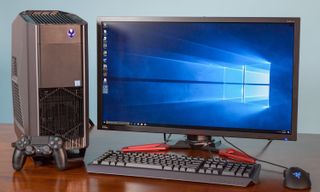
The 18.6 x 14.2 x 8.35-inch, 32-pound Aurora is pretty hefty, though a convenient carry handle up top makes the computer easy to lug around. It's not quite as compact as Dell's XPS Tower (15.22 x 14 x 7 inches), but it's a bit sleeker than other midsize competitors, such as the MSI Infinite (19.2 x 17.7 x 8.3 inches) and Digital Storm Vanquish (20 x 17 x 8 inches).
Of course, it wouldn't be an Alienware product without customizable lighting. Using the PC's Alienware Command Center app, you can have the desktop's left panel, right panel and front-facing power button glow a myriad of different colors, either by choosing from one of several presets or by picking your own colors for each zone.
The Aurora's lighting is pretty subtle by gaming-desktop standards, but I enjoyed being able to swap out the desktop's default blue hues for some soothing purples and pinks. I also appreciated how the Command Center app instantly recognized my Alienware Gaming Keyboard, and made it easy for me to match up the peripheral's lighting with that of my desktop.
Key Specs
Starting
Configuration
|
Our Configuration
|
|
CPU
|
Intel Core
i5-8400
|
Intel Core
i7-8700K
|
GPU
|
AMD Radeon RX 560
|
Nvidia GTX 1080
Ti
|
RAM
|
8GB
|
32GB
|
Storage
|
1TB hard drive
|
512GB SSD, 2TB
hard drive
|
Size and Weight
|
18.6 x 14.2 x
8.35 inches, 32 pounds
|
18.6 x 14.2 x
8.35 inches, 32 pounds
|
Ports and Upgradability
The new Aurora's port layout is largely unchanged, save for one important addition: a USB-C port right up front. This brings the Aurora up to par with machines such as the Dell XPS Tower and MSI Infinite, and makes it easy to quickly charge up or connect any of your USB-C gadgets. Other than that, you've got your usual array of three USB 3.1 ports and headphone and mic jacks in the front.
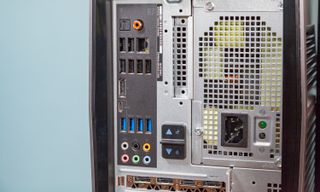
The back of the Aurora is loaded with more USB connections than you'll probably ever need, including six USB 2.0 ports, four USB 3.1 ports and an additional USB-C port. You'll also find a full suite of audio ports, an S/PDIF jack for optical audio gadgets and an Ethernet port. The system's Nvidia GTX 1080 Ti graphics card sports its usual HDMI port and trio of DisplayPort connections, giving you plenty of options for connecting your monitors.
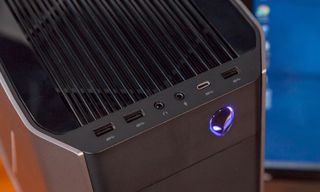
As with previous iterations, the Aurora's key feature is upgradability. The desktop's side panel pops off with a quick pull of a lever, and once you're inside, you can slide out the power supply and remove the graphics card, storage drives and RAM, all without using a single tool. The panel release lever on our review unit was screwed in to keep the machine safe during shipping, but once that screw was removed, I could enjoy the same tool-free tinkering that makes the Aurora (as well as its XPS Tower cousin) such a painlessly upgradable system.
Gaming and VR Performance
Sporting an Nvidia GTX 1080 Ti graphics card alongside Intel's new 8th-Gen Core i7-8700K processor, our Aurora handled every game we threw at it with aplomb.
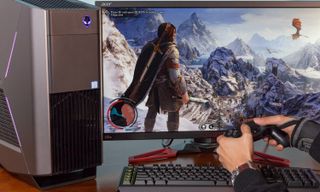
When playing the Injustice 2 PC beta on Alienware's machine with all settings turned up, I noticed every little detail, from the stitchings of Robin's suit to the intricate purple patterns that adorn Brainiac's ship. Better yet, the Aurora consistently ran the game's benchmark at 59 frames per second, even at 4K with graphics maxed out.
The Aurora made an excellent showpiece for the graphically rich Rise of the Tomb Raider, rendering the game's gorgeous environments at 85.8 frames per second at 1080p with all settings maxed out. That's just behind our Origin Chronos (95.4 fps, GTX 1080 Ti), while topping our Corsair One (72 fps, GTX 1080) and our 54-fps desktop average. When we bumped the game to 4K with all settings cranked up, the Aurora turned in 28 fps, which is just barely below our 30-fps playability threshold.
When moving to the slightly less demanding action of Hitman (1080p, max settings), we got a silky 97.2 fps. The Aurora fell to the Chronos (127.6 fps) and Corsair One (129 fps) while once again topping our 86-fps category average.
Unsurprisingly, the Aurora's powerful guts maxed out the SteamVR Performance Test with a score of 11, making the Alienware machine more than ready for high-fidelity virtual reality. That score ties results from the Chronos and One, and tops our 10.1 average.
The Aurora scored 6,763 on the 3DMark Fire Strike Ultra test, which gauges 4K performance. That's on par with the Chronos' mark (6,705) and better than the One's result (5,032), as well as our 4,656 average.
Overall Performance
Thanks to its 8th-Gen Core i7-8700K and 32GB of RAM, our Aurora proved to be as beastly at everyday multitasking as it was at gaming. The system never slowed when I piled on activities, even as I bounced among six Twitch streams, opened over a dozen browser tabs, ran a full-system scan and downloaded a game on Steam.
The PC netted a 24,196 on the Geekbench 4 performance test, topping the Origin Chronos (21,585; AMD Ryzen 7-1800X), the Corsair One (17,755; Core i7-7700K) and our 18.641 gaming-PC average. To put the benefits of Intel's 8th-Gen processors in perspective, our 6th-gen Aurora (Core i7-6700K) scored 16,398 on Geekbench 3 last year.
The Aurora's 512GB SSD transferred roughly 5GB of data in a speedy 13 seconds, for a transfer rate of 382.3 MBps. That's not quite as fast as our Chronos' 500GB SSD (828.3 MBps) or our 428.6-MBps average, but it outpaces the Corsair One's 480GB SSD (236.6 MBps).
Alienware Command Center
Aside from letting you light the Aurora up in all kinds of cool colors, the Alienware Command Center app offers a healthy number of tools for monitoring and customizing your system. The app's AlienFusion tab gives you a detailed look at your machine's power consumption, while the Thermal Controls section lets you monitor and adjust the desktop's heat output. The app also lets you set up handy Game Modes, which allow you to program a set of actions to occur (such as firing up Fraps and Discord) every time you launch a game.
Configurations and Value
which gets you an Intel Core i5-8400 processor, 8GB of RAM, a 1TB hard drive and an AMD Radeon RX 560. Stepping up to the model gets you VR ready, with a GTX 1060 graphics card and 16GB of RAM, while the highest-end,config features a Core i7-8700 processor, a 256GB SSD with a 2TB hard drive, and a GTX 1080 for maxing out the latest and greatest titles.
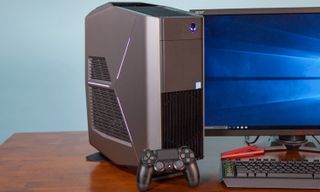
You can customize these models at the point of purchase, adding extras including up to two GTX 1080 Ti graphics cards , up to 64GB of RAM and as many as two 1TB SSDs . Our custom configuration gives a good idea of what tricking out the Aurora looks like, as this model sports a Core i7-8700K CPU, a GTX 1080 Ti GPU, 32GB of RAM and a 512GB SSD with a 2TB hard drive.
If you want the latest CPU and GPU options, you should spring for the newer Alienware Aurora R8 series. This version of Alienware's desktop starts with a 9th Gen Intel Core i5-9600K processor, 8GB of RAM, a 1TB hard drive and an Nvidia GTX 1060, but can support up to an overclocked Core i9 CPU and Nvidia's new RTX 2080 Ti graphics card for those who want to go all out in 4K with some ray tracing thrown in.
Bottom Line
The Alienware Aurora is still the best overall blend of design, power and upgradability you can get for the money. Its slick chassis and customizable LED lighting will make it stand out in your command center, and its painlessly easy-to-upgrade internals make it future proof for even the most technically averse gamers. And with support for Intel's 8th Gen Core processors and Nvidia's GTX 1080 Ti graphics cards, it's a legitimate 4K and VR beast.
If you want the same easy upgradability within a more subtle design, Dell's XPS Tower Special Edition is an excellent alternative. If you want something more compact without sacrificing too much expandability, the Origin Chronos is worth considering. But if you're looking for an attractive, LED-backlit tower that you can expand over time, the Aurora hits that sweet spot like few machines can.
Alienware Aurora R7 is a powerful pre-built gaming PC for those that don’t want to build their own. Hardcore gamers may turn down their nose, but with its impressive spec configurations, tool-less case access, and countless upgrade options in the future, the R7 is a capable gaming rig.
For our review, we tested the Alienware Aurora R7 configured with an Intel Core i7 8700, Nvidia GeForce GTX 1070 8GB, 1TB HDD, 256GB M.2 PCIe SSD storage, and 16GB of RAM. Read on to see how it fared in games, benchmarks, and day-to-day use and see if it’s worth the high price.
:max_bytes(150000):strip_icc():format(webp)/2LW4045927-4-0a0b8fbcdc824e1c9abf26cdd1ef57c4.jpg)
Lifewire / Gannon Burgett
Design: No need to whip out your toolbox
Taking inspiration from other computers in Dell’s lineup, most notably the Area 51 PC, the Aurora R7 features a black and gunmetal exterior with plenty of ventilation on the top, sides, and bottom of the case. There’s also an array of customizable RGB lights on the side that can be changed to whatever colors suit your style.
One of the standout features of the R7 is its tool-less design. Unlike other PC cases which often need screwdrivers to open, the Aurora R7 can be opened with a simple pull of a lever on the back of the PC. Once the side cover is off, two other switches on the back of the PC are used to unlock the power supply arm, which swings out to reveal the internals of the Aurora R7. The cables are neatly tied and routed throughout the computer, staying out of the way of the AIO liquid CPU cooler.
Unlike other PC cases, which often need screwdrivers to open, the Aurora R7 can be opened with a simple pull of a lever on the back of the PC.
In terms of ports, the Aurora R7 isn’t lacking. On top of the case, there are three USB 3.0 ports, one microphone port, one headphone port, and a single USB Type-C port. While we would’ve liked to see one more USB Type-C port on the front, the arrangement as is worked well for various devices we wanted quick access to plug in and remove, such as headphones and hard drives.
On the rear of the device, there is no shortage of connections. The back has four USB 3.1 ports, six USB 2.0 ports, a USB-C port, a complete set of audio connectors including an optical input, and an Ethernet port. Finally, you have a display port for the motherboard, but your GTX 1070 will have its own set of display ports.
:max_bytes(150000):strip_icc():format(webp)/2LW4045927-6-5c5c421e3ce842339e931c622f5ee7fc.jpg)
Lifewire / Gannon Burgett
Setup Process: Complex settings, simplified
Setting up the Alienware Aurora R7 was fairly straightforward. In the box was the tower, a mouse, a keyboard, and the power cable. After connecting the Aurora R7 to power, plugging in the mouse and keyboard, and attaching a monitor, it was just a matter of going through Window 10’s setup process to get the ball rolling.
Performance: It’ll take nearly anything you throw at it
The Alienware Aurora R7 model we tested was configured with an Intel Core i7-8700 CPU, an NVIDIA GeForce GTX 1070 8GB graphics card,16GB of RAM, and a 256GB M.2 PCIe SSD powering the operating system and apps. Meanwhile, a 2TB HDD served as the mass media storage.
As is to be expected with the above specs, the Aurora R7 flies. It’s not the top-of-the-line configuration, but it doesn’t disappoint either. Boot-up time ranged from 10 seconds to 20 seconds, and applications opened with ease thanks to the integrated M.2 SSD. Multitasking was equally impressive, handling a dozen files open in Adobe Photoshop just as easily as half-a-dozen Twitch streams. Thanks to the liquid-cooling for the CPU, it stayed impressively quiet through it all.
Diving into the benchmark details of the Aurora R7, we tested our configuration with Geekbench, Cinebench, and PCMark to see how the Intel Core i7-8700 CPU, NVIDIA GeForce GTX 1070 8GB graphics card, and other components stacked up.
Boot-up time ranged from 10 seconds to 20 seconds, and applications opened with ease thanks to the integrated M.2 SSD.
In our Geekbench test, the Aurora R7 scored 5,678 on the single core test and 24,989 on the multi-core test. This falls in line with other PCs with similar specs. On the Cinebench front, the Aurora R7 clocked in 146.64 fps in the OpenGL test and 1335 cb in the CPU test. Last up was the PCMark test. The Aurora R7 scored a 6183, with 8681 in Essentials, 8303 in Productivity, and 7526 in the Digital Content Creation tests.
Overall, the Aurora R7 tested on-par or ahead of other PCs with similar specs. As is to be expected, it excelled in the graphics department, but it certainly didn’t struggle with multitasking and everyday tasks.
:max_bytes(150000):strip_icc():format(webp)/2LW4045927-5-05e1d507405c4e0288fa00242bf06396.jpg)
Lifewire / Gannon Burgett
Network: Powerful, consistent connections
The Alienware Aurora R7 has both wired and wireless connectivity for internet access. On the rear of the PC is a Gigabit Ethernet (RJ-45) port for a hardwired internet connection. On the wireless front, the Aurora R7 uses two external 5GHz amplifiers for strong uplink and downlink speeds. These are boosted by Alienware’s Killer Wireless, an internal lag and latency reduction technology to improve long-distance range and intelligently prioritize the most important traffic.
In our hardwired tests, the Aurora R7 easily achieved perfect speeds across the board for our Gigabit fiber optic connection. The wireless connection proved nearly perfect as well, with steady speeds both up and down, with minimal ping. Regardless of whether we were gaming or downloading large video files, the computer kept up connection whether it was next to the router or three rooms away.
:max_bytes(150000):strip_icc():format(webp)/2LW4045927-3-21501d80d0d84039b9db4cc0e924b13e.jpg)
Lifewire / Gannon Burgett
Software: Baked in goodies to simplify a few pain points of gaming
As is to be expected for a gaming PC, the Alienware Aurora R7 runs on Windows 10 64-bit. It’s a typical install in every sense of the word, but it does come with a few extra bits of software specifically designed for Alienware, including Alienware Command Center, AlienFusion, and OC Controls.
Alienware Command Center is a new program that controls nearly every facet of the Alienware hardware, including custom controls depending on what game is being played. Built-in it has AlienFX, which customizes the external RGB lighting of the computer based on your style preferences. We spent far too much time in there customizing our desktop and only scratched the surface of our options.
There’s also an array of customizable RGB lights on the side that can be changed to whatever colors suit your style.
AlienFusion is an Always Ready mode that comes pre-installed to make it easy to sleep and wake the computer. This allows the core components to keep running while keeping energy consumption to a minimum. In our experience, it worked well to save energy while not entirely turning the computer off between uses.
OC Controls is a dedicated program for controlling overclocking levels of the memory and CPU. The program not only makes it easy to control the overclocking settings, but also helps you keep an eye on temperatures while you game.
Price: Pricey compared to DIY, but otherwise a solid value
The Alienware Aurora R7 with the aforementioned specifications retails for (MSRP). Compared to other pre-built computers, it’s a bit high as we’ll see below. It’s also a good bit more expensive than other DIY gaming builds. Convenience isn’t cheap and the Aurora R7 is no exception.
You could you easily build a PC with better specs for less money, but you also have to take into account the amount of time it takes to shop around for various components and build the computer. If building gaming PCs is something you’re interested in, then skip the Aurora R7 and start your own build. However, if you want to get started with gaming or VR without worrying about compatibility and the building process, the Aurora R7 has plenty of configurations that can suit your needs.
:max_bytes(150000):strip_icc():format(webp)/2LW4045927-2-dbdd27635b4a47e6bb7ccdd54bb7d952.jpg)
Lifewire / Gannon Burgett
Competition: Convenience rules above all else
Judging competitors of the Alienware Aurora R7 can get incredibly tricky considering all the different configurations available, not to mention the option of building your own computer. That said, one pre-built gaming PC stands out alongside the Aurora R7 in terms of specs and value—the MSI Infinite X.
The Aurora R7 and MSI Infinite X come both come in multiple configurations, with each variation lining up almost spec-for-spec with each other. Compared to our Aurora R7, the closest contemporary in the MSI Infinite X lineup is the model with the Intel Core i7-8700K CPU with the NVIDIA GeForce GTX 1070 graphics card, a 256GB PCIe NVMe SSD, and 16GB of dual-channel DDR4-2400 RAM.
On spec sheets, the two computers line up almost identically, aside from a few ports and connection points. Design wise, the MSI Infinite X is a little less appealing as tools are needed to access various parts of the case, but what it trades for in convenience, it makes up for with internal and external RGB lights that give a much brighter pop of color than the Aurora R7.
The MSI Infinite with the aforementioned specs retails for , whereas the Alienware Aurora R7 with the aforementioned specs retails for . This isn’t much of a difference, especially when you take into account the difference in quality components used, such as the power supply and means of cooling, but it’s still worth considering as a slightly more affordable alternative.
Final Verdict
A powerful, convenient machine out of the box.
The Alienware Aurora R7 is a wonderful option if you’re looking for a pre-built gaming PC that requires little to no hands-on time to get up and running. Out of the box, it’s ready to take on nearly any game you throw at it, usually at the highest settings. Sure, it’s a bit pricier than a DIY PC, but its compact case, tool-less access, and upgradability makes it a solid option for someone who wants a plug-and-play gaming rig.
Evolved, Inside and Out
The Alienware Aurora features a meticulous, zero-fat
design and is the first to offer tool
-less upgrades to graphics cards, hard drives and memory.
Designed to keep cool.
Inspired by the thermal ergonomics
of the Area-51, the Aurora provides optimal air intake on
the front and right panels and an exhaust fan
on top for maximum airflow and cooling of internal components.
Uncompromising Performance
Engineered to overclock: The Alienware Aurora was designed to
fully support custom upgrades with available 8th Gen
intel core processors factory overclocked
up to 4.6GHz across all 6 cores and 16GB of DDR4 at 2666 MHz.
High-speed and hardcore: Maximize gaming performance
High-speed and hardcore: Maximize gaming performance
and capacity with 32GB Intel Optane memory
accelerated 2TB 7200RPM HDD.
Alienware Command Center
AlienFusion: The new Always Ready Mode puts your
Alienware Command Center
AlienFusion: The new Always Ready Mode puts your
system in a state in between sleep and awake,
allowing core programs to run in the background
while the machine runs quietly and in a lower power mode.
AlienAdrenaline: Featuring customizable game and application,
AlienAdrenaline: Featuring customizable game and application,
a system performance optimizer and a performance monitoring tool,
AlienAdrenaline provides users all the tools they need to keep one step
ahead of the competition.
OC Controls: Take control of overclocking levels for your memory and CPU
OC Controls: Take control of overclocking levels for your memory and CPU
with OC controls. Monitor memory activity levels, change settings on the fly,
and turn on/off auto start in one convenient place. With customer OC, you can
Engineered for the Future
Innovative, tool-less access: A uniquely designed PSU swing-arm
keeps graphics and expansion cards safely secured and easy to upgrade –
along with memory modules and 5 storage drives – thanks to tool-
less accessibility.
Iconic & quiet design: Customizable AlienFX lighting gives the Aurora a distinct,
dynamic look and its whisper-quiet operation allows you to get lost in the game
without noisy distractions.
Thermal Controls: Change settings and monitor internal temperatures and
Thermal Controls: Change settings and monitor internal temperatures and
speeds of certain fans within your PC using the Active Thermals module.
NVIDIA GeForce 1080
Stunning graphics capabilities: Tested and bench marked at
UHD 4K resolution and beyond in games and synthetic benchmarks,
the Aurora
offers brilliant resolution and exceptional frame rates,
with graphics like NVIDIA GeForce GTX 1080.
NVIDIA’s flagship GeForce GTX 1080 is the most advanced
gaming GPU on the planet, driven by the high-performance,
power-efficient new NVIDIA Pascal architecture.
Pascal enables truly game-changing performance with captivating
sights and sounds, as well asnext-generation VR performance that
offers the lowest latency and plug-and-play compatibility with leading headsets.












Alienware Gaming Pc Desktop Aurora R7
ReplyDelete-
Gaming Pc Ex Cool >>>>> Download Now
>>>>> Download Full
Alienware Gaming Pc Desktop Aurora R7
-
Gaming Pc Ex Cool >>>>> Download LINK
>>>>> Download Now
Alienware Gaming Pc Desktop Aurora R7
-
Gaming Pc Ex Cool >>>>> Download Full
>>>>> Download LINK un